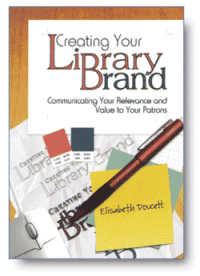 |
| This book includes insights from big business as well as examples from libraries. |
|
Most professional books are written by experts in their field, yet some people are more “expert” than others. As soon as I saw the credentials of this author, I was excited. Elisabeth Doucett has an M.L.S. (from Simmons) and an M.B.A. as well (from Northwestern). Not only that, but before becoming a librarian, she worked for 15 years in the business world, doing marketing and consulting for Kraft Foods, Quaker Oats, and Dunkin’ Donuts. If you are familiar with those companies’ brands, then you might want to pay attention to what this woman says about branding.
If you think that branding is all about having a logo and building an image, well, yes, that’s part of it. But branding goes deeper; it’s also about communication, as you might have surmised from the book’s title, Creating Your Library Brand: Communicating Your Relevance and Value to Your Patrons. Doucett defines it in detail in her Preface:
Branding is a component of the marketing process. It defines to whom you want to talk about your product ... articulates a clear message about what makes your product unique and meaningful, and conveys that information in a method that captures the potential customer’s attention and encourages him to action.
Branding helps libraries develop a laser-sharp message about the role they play in their communities, and it helps them ensure that the message is delivered in a way that will have a measurable impact on potential users.
If you didn’t realize that this was what branding was about, then run out and buy this book! It was designed so that readers who already had some familiarity with the process could just read the chapters that they needed. So you don’t have to read all the way through to benefit from it. You might want to choose certain topics, such as brand audits, defining your message, attention-grabbing visuals, or evaluating or maintaining your brand.
One of the things I learned while reading this book was that there are four elements of a great brand:
1. A clear, meaningful, unique message
2. An attention-grabbing visual identity
3. Consistent use
4. An ongoing effort to keep the brand honest
The fourth element is one I hadn’t considered, but it makes sense when the author explains that your brand should not promise more than it can deliver. She uses the example of a toothpaste ad implying too much, as in “Use this toothpaste and you’ll be rich and sexy.” This jibes with the customer-service tenet of “Under-promise, over-deliver.”
Much of the advice in Creating Your Library Brand is common sense, such as “match your message to your community” and “use your brand consistently,” but that’s not to say that this book isn’t important. It defines branding broadly, explains why brands matter, includes insights from big business as well as examples from libraries, and it clearly spells out what you need to do to have a winning, memorable brand. This is an easy but important read that’s worth your time. |